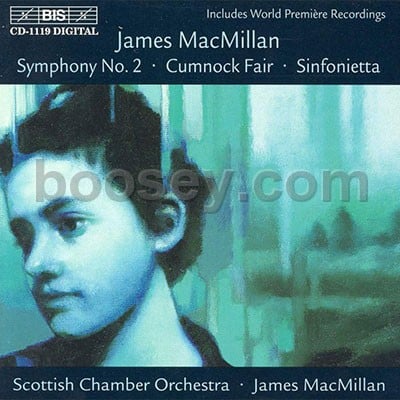2(II=picc).2(II=corA).2(II=bcl).1.dbn-2.2.0.0-perc(2):glsp/vib/
t.bells/bell-tree/bongo/SD/BD/cyms/tam-t-harp-strings
Abreviaturas (PDF)
Boosey & Hawkes
This work, composed in 1999, is in three movements and lasts about 25 minutes. It is dedicated to the writer and fellow Ayrshireman Andrew O’Hagan.
The first movement is short and preparatory. It opens with the first of many mournful, tolling bell strokes and is followed by a mounting clamour of high woodwind calls. This then merges with the pitter-patter "rain-drops" of high pizzicato strings before settling to the main substance of the movement. This is carried by a sad chorale on brass (and later other winds), punctuated by rippling flurries on flutes and clarinets, and brittle repeated chords high on the harp. These various ideas are gathered up into a more expressive statement before the music subsides and fades.
The sense of elegy and desolation is continued into the more extended second movement, but this time there is more - ferocity and violence. The music progresses and develops as a series of ruminative fragments and memories of previously stated material – melancholic two-note figures (which come from the bell idea), long arching, floating melodies which hang in the air without ever quite resolving, snapping semi-quavers on woodwind and brass, and "military" bursts of snare-drum.
Twice a low, lurching rhythmic pulse gets going over which a menacing, martial theme on the brass is built, but again the music drifts dreamily in other directions with smooth cantabile fragments or other nervous activity in suspended animation. These ideas all exist as if on a short fuse, edging uneasily into a dialogue. An ominous pulse on brass, low woodwind and bass drum is set up from which a florid melody appears on cor anglais. Again this is interrupted by material marked "floating, light, delicate" or "intense (dolente)" or by a single percussive idea evoking a distant marching band.
This interaction of contrasting ideas continues and is gradually whipped up into a more and more frenetic and emphatic interplay. This activity is eventually gathered towards a loud, violent shuddering chord from which the music winds down through the descending strings. A slow, calm stasis follows marked "patetico" and "desolate". The ominous pulse returns as the snare drum grows out from the distance, gradually becoming more dominant and loud before a sudden halt.
The third movement is a brief postlude, almost an afterthought to what has been heard. The same mood prevails. The general sweep of the music is from low to high, taking in some free, aleatoric scurrying, the briefest evocation of a compound dance rhythm and some "tristanesque" moments of repose. The cellos (later joined by violas) emerge with a series of internal pedal points which at certain moments become more "melodic".
Piccolo, tubular bells and harp play out on some of the principal memories of the earlier movements over some genuine quotations from Tristan and Isolde which are subjected to some queasy stretching and sliding on the strings.
Taking my lead from composers such as Boulez and Berio I have built this work on an earlier, shorter piece – my Piano Sonata of 1985. The original is "opened up" to new forms of expansion, sometimes according to colouristic potential, other times to dramatic or even originally unseen potential. Sometimes new layers are added, such as the march, sometimes material has been projected into new contexts.
James MacMillan, 1999
Reproduction Rights
This programme note can be reproduced free of charge in concert programmes with a credit to the composer
"This is a brilliantly written chamber-orchestral score... there is clearly more to MacMillan's Second than a coherent, thematically integrated three-movement construction... behind it all, as with the Piano Sonata on which it is based, there is the harsh Scottish winter landscape."
The Times

Scottish Chamber Orchestra / James MacMillan
BIS CD 1119

